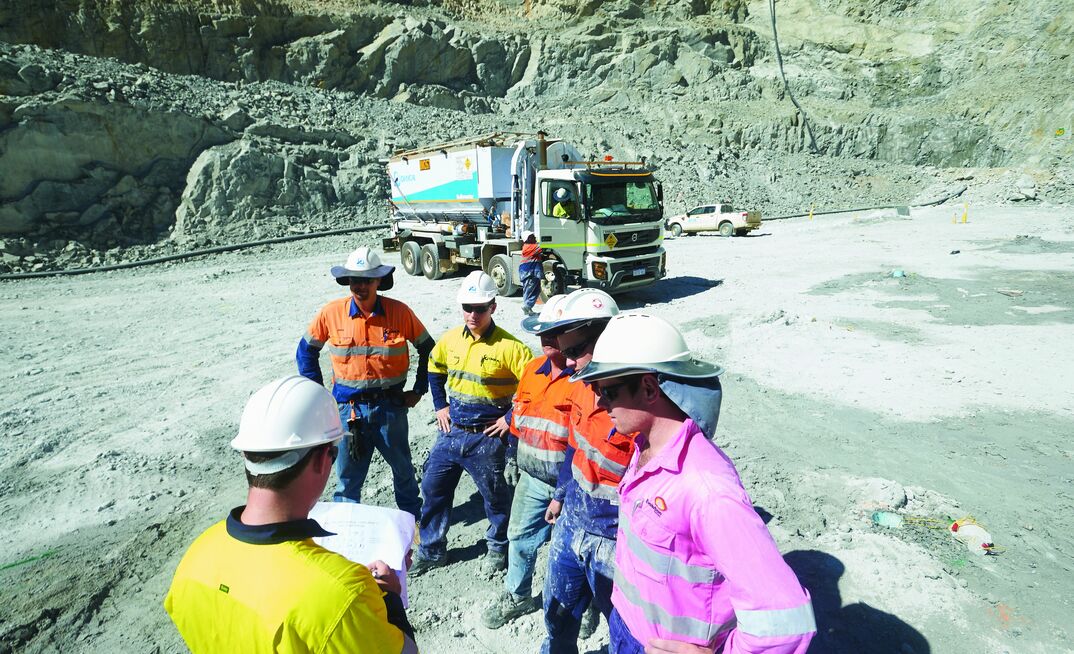Actually, besides making use of a brand new Orica product, which definitely improved fragmentation, Evolution Mining’s Mt Rawdon operation also took a different tack. It allowed its mill operations team to become far more involved with the general mining process than normal. That could become a blueprint for other operations to improve outcomes.
Evolution’s Mt Rawdon operation, 75km southwest of Bundaberg in Queensland, is a low grade mine – 0.7-1 grams per tonne. It is expected to turn out about 100,000 ounces of gold in the 2016-17 financial year.
Evolution worked with Orica, which decided to trial its newly-introduced Vistis Bulk System, a range of high energy bulk explosives for hard rock metal mines.
Vistis produces more than three and a half times the detonation pressure of ANFO at triple the relative bulk strength is what the system offers.
The energy levels generated and the speed with which they are released delivers better fragmentation. That, in turn, reduces overall operating costs either through pattern expansion without impacting load and haul rates, or by providing better broken stock that increases milling efficiency.
Orica’s high energy range consists of two primary bulk explosives: Vistis and Vistan.
The Vistis range is designed specifically for wet blast holes while Vistan is for use in dry or dewatered blast holes.
Orica was able to demonstrate milling and mining efficiency gains at Evolution Group’s Mt Rawdon operation through better blasting.
While the trial revolved around blasting, it showed what can happen when the mill is given a greater say in other parts of the mining process such as planning, load and haul and drill and blast.
Orica has worked at Mt Rawdon since the mine started in 1998.
It dispatched a technical solutions engineer for a two month period to work out whether this would work – as well as cover a leave absence of a site engineer.
While the mill was working at near full capacity, there was, however, some variation in mill feed. If that could be controlled, greater mill throughput should result.
The decision was made to take a mill productivity approach, improve fragmentation as a whole and open up more options to allow the mine to treat the material in a way that stabilised and maximised throughput.
The first stage of the project was to assess the effect of blast energy on fragmentation and mill throughput.
Initially this was done via a tighter drill pattern, using conventional explosives at specifically double the powder factor used in Mt Rawdon’s normal blasts.
While some increased fines were produced from this technique, the damage to the blast perimeter was much greater, resulting in an increased number of large rocks being sucked into the muckpile.
It was hard to see a benefit in both fragmentation and mill throughput.
Given the site was already drill constrained it was decided this solution was not suitable.
It was decided to bring in a high-energy bulk explosive system Vistis 250.
An Orica engineer designed three trial blasts using Vistis 250 in conjunction with the timing provided by electronic blasting.
The results of that blast were compared with the existing baseline of Fortis Advantage and the Stage 1 high powder factor blast.
The results were obvious. The higher energy of Vistis 250 seemed to deliver much finer, more consistent fragmentation than the conventional Fortis Advantage blasts.
However, while the material was most definitely finer, the method used to assess the impact of Vistis was fundamentally flawed.
In trying to isolate as many variables as possible, each flitch of the baseline and Vistis blasts were mined and milled immediately after each other to give a direct comparison.
Given the batches of material were relatively small and the two blast results were significantly different, the mill was never able to stabilise and the throughput was “total chaos”.
While there were some promising signs the overall results were blurred and it was hard to discern any improvement.
After considering what was learnt in Stage 2, it was obvious the solution needed to be more than just blasting. It needed to be truly from the mine site to the mill.
Instead of focusing on individual inputs and shot-by-shot comparisons, Stage 3 would be run over the much longer period of three months.
In addition, the run-of-mine pad was redesigned to give room to blend material types and make reactive changes to the feed. Operators were trained on optimising the plant.
Most importantly the mill played a much larger role in activities that were normally left to mining such as planning, load and haul and drill and blast.
Over the three month trial the mill throughput rate increased nearly 6% compared to the baseline.
Better yet, the corresponding specific energy reduced by more than 7% and semi-autogenous grinding mill recirculation dropped by more than 22%.
The overall variation in mill throughput decreased due to a more consistent feed.
Also dig rates increased by about 15% in Vistis blasts.
After seeing the change with the Vistis 250 blasts there was an investigation as to whether Vistis 225 could be used to expand patterns in waste and ultimately reduce the total cost of drill and blast.
Depending on the geological domain, patterns were expanded between 45% and 60% with no adverse impact on dig rates.
This resulted in lower net drill and blast cost. More significantly, perhaps, the mine was able to unconstrain its drill fleet and increase the mine’s productivity.
The overall financial benefit from the mill productivity is significant.
Even though drill and blast costs in the ore have increased, the overall net benefit to Mt Rawdon, including mining and processing costs, is expected to be more than $5 million.
While the Vistis system is a key input to the mine to mill program the benefits Mt Rawdon achieved are equally attributable to the operational changes it made.

























